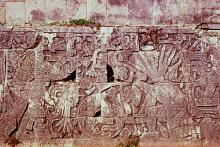Chaaj
Solapas principales
Tedlock points out that cha’j is used for the game ball in Xib'alb'a while kik’ -- which also means "blood" or "resin" -- refers only to the ball of Juajpu and Xb’alanke. Perhaps this wordplay solidifies a semantic connection for the Maya, allowing kik to refer to balls and, more distantly, to humans’ interaction with the supernatural through sacrifice or ball game challenges.
The ball in Xib'alb'a further differs from a normal ball in that it appears to the boys to be a skull. It was previously described as being coated with crushed bone; Tedlock says that what is played off as “mere decoration” by the Lords is actually a fundamental and sinister difference. Reference to this bone-ball as kik’, the word for “ball” easily associated with blood and death, seems fitting for this particular object despite the more customary use of cha’j for Xib'alb'an game balls.
Ch'aj, the more generic word for ball, is reserved for reference to balls used by the Lords of Xib'alb'a. Considering the connection between the kik' and sacrifice, perhaps cha'j are used by Xib'alb'ans because there is no need for them to establish a connection with the supernatural -- they are the supernatural. The distinction bewteen cha'j and kik' further supports the idea that rubber and the ballgame represent the other mode of reaching the divine: blood and sacrifice.
In an extensive footnote, Mayanist scholar Allen J. Christenson (2007: n378) notes the importance of the ballgame throughout Mesoamerica. He writes, "The ballgame was played throughout Mesoamerica beginning at least by the time of the Olmecs ca. 1500 B.C. Although the rules varied over time and from region to region, it generally involved opposing teams of two or more players attempting to bounce a solid rubber ball without the use of hands through a ring placed vertically along the ballcourt’s walls. Sahagun described a similar type of ballgame among the Aztecs in the sixteenth century:
These balls... were solid, of a certain resin or gum which is called ulli [rubber] which is verylight in weight and bounces like an inflated ball.... The ballgame was called tlaxtli or tlachtli. The court consisted of two walls with some twenty or thirty feet of distance between them and each was up to forty or fifty feet in length. The floor and walls were heavily plastered, the latter having some one and a half estados [nearly ten feet] in height. In the middle of the court was a line made especially for the game; and in the middle of the walls, halfway down the playing stretch, were two stones like millstones perforated in the middle, facing each other, and they each had holes wide enough that the ball could fit into each of them. And whoever placed the ball there won the game. They did not play with their hands but hit the ball with their flanks. For playing they wore gloves on their hands and a leather apron on their flanks to hit the ball (Sahagún 1938, II.viii.10, pp. 297-298).
As part of his explanation of the ballgame imagery in vase #2803, Justin Kerr includes Alexandre Tokovine's essay, "An Epigrapher's View."
El antropólogo Dennis Tedlock (1996) señala que cha’j es usado para la pelota que usa usa generalmente en el juego en Xib'alb'a mientras que kik’ – término que también significa “sangre” o “resina” – refiere solamente a la pelota de Juanjpu y Xb'alamq'e. Tal vez este juego de palabra resalta una conexión semántica para los Maya, en la que kik’ se refiera a las pelotas y, más distante, a las interacciones humanas con lo supernatural a través de un sacrifico o desafíos del juego de pelota.
La pelota en Xib'alb'a se diferencia aún más de una pelota normal en que a los niños les parece un cráneo aplastado. Previamente, tal pelota era descrita como algo recubierto de hueso triturado; Tedlock dice que lo que los Señores la interpretan como “mera decoración” la cual característica es en realidad una diferencia fundamental y siniestra. Si bien la palabra kik’ típicamente quiere decir “pelota”, fácilmente es asociada con sangre y muerte. De esta manera parece un término apropiado para esta pelota de huesos.
En cambio, la palabra más genérica para pelota, cha’j, está reservada para las referencias a pelotas usadas por los Señores de Xib'alb'a. Considerando la conexión entre el kik’ y el sacrifico, a lo mejor cha’j es usado por los de Xibalba porque no hay ninguna razón para establecer una conexión con lo supernatural – ellos son lo supernatural. La distinción entre cha’j y kik’ suporta adicionalmente la idea que la goma y el juego de pelota representan el otro modo de alcanzar lo divino: sangre y sacrificio.
En su traducción moderna del k'iche' al español, el lingüista k'iche' Sam Colop (2008: 41n65) define la voz chaaj asi: "Juego, diversiónn; aunque Chaaj es propiamente el Juego de la pelota y, a veces se usa para identificar a la pelota misma (Ximénez, Basseta)." Se observa que "chaaj" se traduce como "jugar" a lo largo del texto, además en las escenas importantes del juego de la pelota. En su introducción, Colop (2008: 19) menciona la dificultad de distinguir entre las palabras chäj (ocote), chaj (ceniza) y chaaj (juego de pelota), pues en la ortografía colonial del padre Ximénez se suele confundir los términos.
Como parte de su explicación de las imágenes del juego de pelota en la vasija #2803, Justin Kerr incluye el ensayo de Alexandre Tokovine, “El Punto de Vista de un Epigrafista.”
